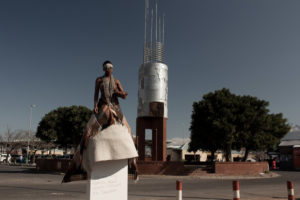Untitled (Heritage Day), 2013, Sethembile Msezane, Courtesy of Artist

Sethembile Msezane stood in front of Louis Botha Statue, Cape Town, South Africa on Heritage Day 2013. Quoted from her personal website, she is a mixed media artist from South Africa. Through a combination of myth and political message, she speaks about the absence of the black female body in historical commemoration.
Untitled (Heritage Day) 2013 is one of Msezane’s performance arts in Public Holiday Series. She dressed like a mythical character while the Louis Botha Statue became background of her performance arts. As Msezane talked in TED2017, Louis Botha is a symbol of the masculinism, dominant figure, white male, and colonialism. The living sculpture that she performs indicates the existence of black women in public space.
She realized that the masculine monuments and architecture scatter around the city where she lives and works–Cape Town. According to Msezane in TEDtalk, it did not only amplify social, gender, and race gap, but also affected black women on how to perceive herself and how is their relation to dominant male figures. Thereafter, she thought that performance art in the form of living sculpture is a better way to preserve public memory about the existence of the black female body.

Another living sculpture that she performs in Public Holiday Series is Untitled (Women’s Day), 2014. She stood up bare-breasted in the Freedom Square, Langa, South Africa. She costumed like her great-grandmother. At first sight, she looks like a goddess. In this artwork, she reacted against the sexual harassment that happened around the place where she performs. Msezane encourages every woman to be brave and evaluates their society.
Msezane’s living sculptures offer a new creative way to counter the dominant ideology that lies behind the historical commemoration at the public spaces. Living sculptures, as part of the post-modern art, break the barriers between creator and audience. It lets the artwork’s message easily permeate into society, because it is usually presented in the public space. People are also free to respond to that artwork. They often pause for a while from their daily activity around the sculpture to see and think about that living sculpture.
Msezane’s artworks are also one of the significant ways to shape public memory. Public memory is about what values and choices that society wants to maintain and also which one that needs to forget. It is manifested in social, history, culture, and political activities. If public memory is a social construct, why we don’t decide to create the equality value as one of the parts of our public memory? Sethembile Msezane has decided race-equality as an important value to be maintained in humans’ public memory.

